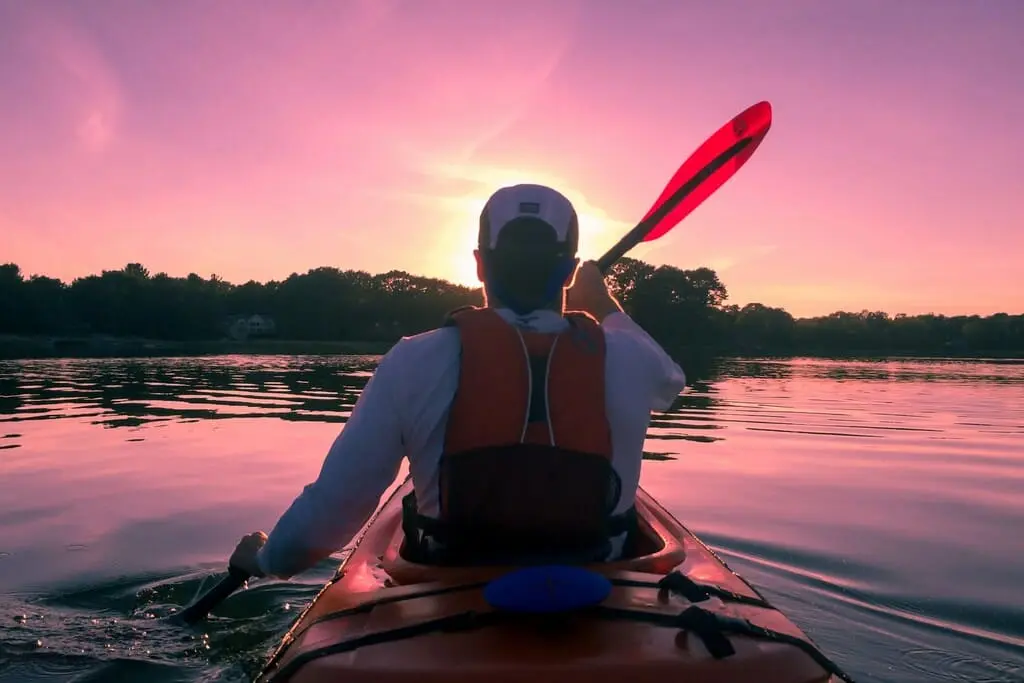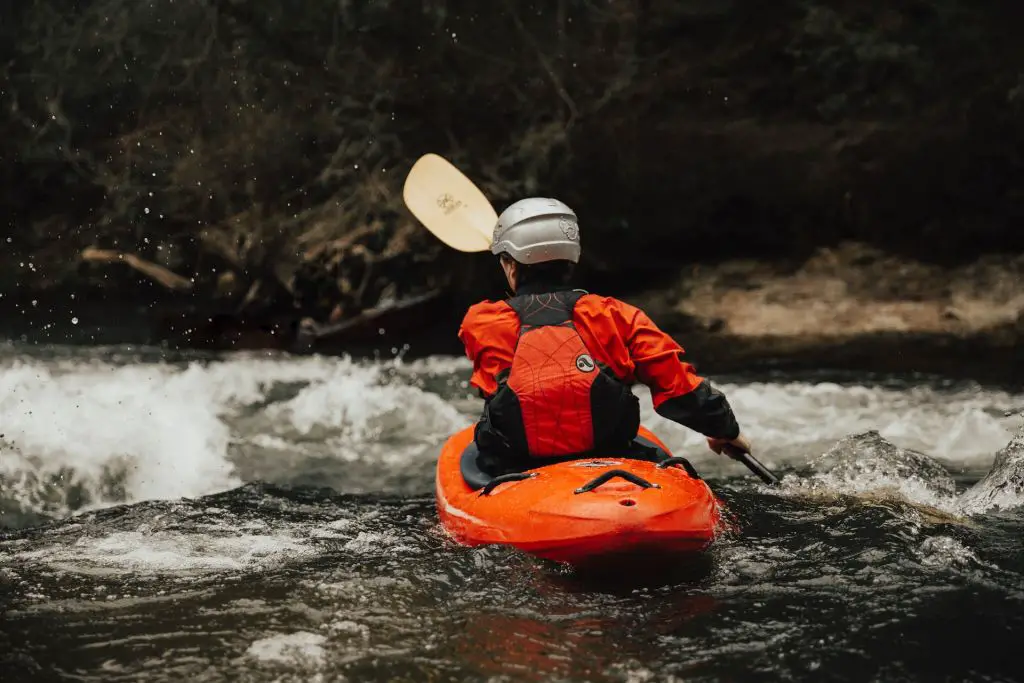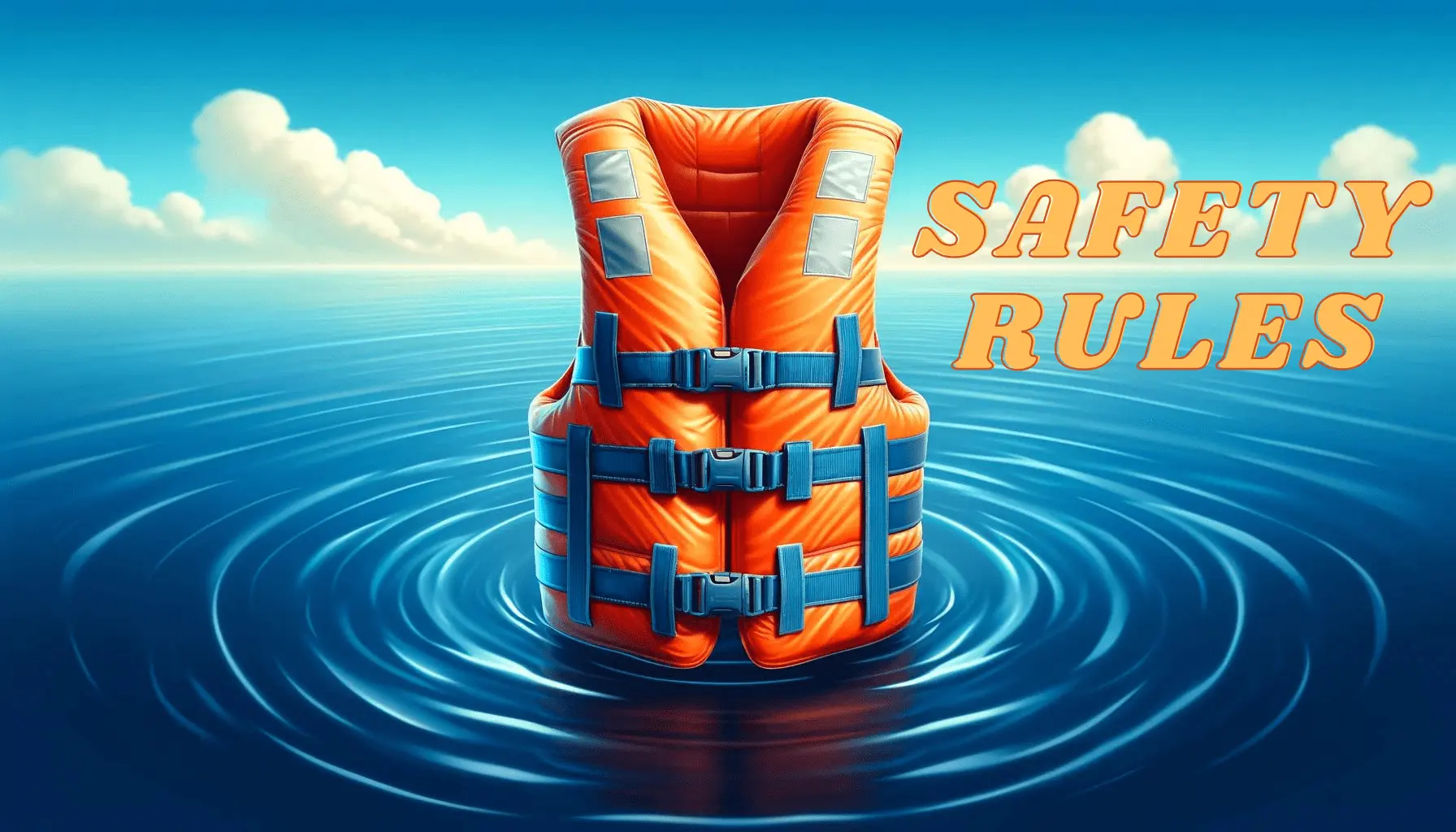As an avid adventurer, I can attest to the transformative experience that kayaking offers. The rhythmic dance of paddle against water, the silent glide over liquid landscapes—and yet, for many, steering a kayak remains shrouded in mystery. Steering isn’t just about survival; it’s about finesse.
Many beginners in the paddling community grapple with how to steer a kayak—often ending up going in circles or zigzagging across the water. But with the right kayak steering techniques and a dose of kayak paddling tips, even a novice can navigate with the poise of a pro. I remember my own struggles and the joy of that ‘eureka’ moment when the principles of movement and balance clicked for me. It’s this transition from tentative paddling to confident maneuvering that makes kayaking a continuously rewarding pursuit.
It doesn’t matter if you’re solo on a serene lake or coordinating with a partner in rushing rapids; beginner kayak steering tips can transform your experience. From the tandem paddler dynamics to the solo paddling strategies—every stroke and maneuver you’ll learn is a step towards mastering your aquatic journey.
Key Takeaways
- Understanding basic kayak steering techniques is crucial for controlled and enjoyable kayaking.
- Solo paddling and tandem paddling require different strategies for effective navigation.
- Beginner kayak steering tips emphasize the importance of coordination and balance.
- Steering methods such as the single-side technique or the sit-n-switch style are pivotal skills to learn.
- Proper guidance can fast-track your shift from uncertain paddling to assured steering.
- Enhancing one’s enjoyment of kayaking comes with confidence in one’s ability to steer proficiently.
Understanding Kayak Steering Basics
As I delve into the world of kayaking, I’ve learned that effective kayak steering is not just about the strength in my arms or the power of my stroke. It’s more akin to a dance with the water, where kayak navigation skills and understanding of the kayak’s interaction with the dynamic water environment lead to a more proficient steering experience.
Dynamic Water Response and Paddle Steering Techniques
Every move I make with my paddle affects the kayak’s path through the water. Knowing diverse paddle steering techniques is essential for maneuvering with precision. When I apply a sweep stroke on one side, the kayak arcs gracefully in the opposite direction. Conversely, a draw stroke pulls the craft sideways, allowing for quick adjustments and tight navigation.
Economy of Motion in Forward and Reverse Paddling
The concept of economy of motion has reshaped my paddling efforts, highlighting the significance of deliberate and efficient strokes. In both forward and reverse motions, I focus on conserving energy by utilizing proper techniques, avoiding redundancy, and ensuring that each stroke serves a purpose – propelling or steering the kayak in my intended direction. This minimalist approach not only boosts endurance but also enhances the joy of kayaking.
Decoding the Kayak’s Design and Its Impact on Steering
The kayak’s design, I’ve found, is not just about aesthetics but plays a pivotal role in its performance. The shape and size of the hull, the distribution of weight, and the overall symmetry – all dictate how the vessel responds to steering inputs. Through personal experience, I’ve come to appreciate how a well-designed kayak can glide smoothly, make responsive turns, and provide stability in a variety of conditions.
How to Steer a Kayak for Solo Paddlers
Mastering the art of solo kayak steering can seem daunting at first, but with the right kayak maneuvering guide and consistent practice, even the most rugged waters can become a paddler’s paradise. The key to success lies within the kayak steering techniques tailored specifically for the solo adventurer.
As I embark on my solitary journey across the glistening expanse, I rely on a blend of skill and intimate knowledge of my kayak’s responses. Here’s how I ensure precise and controlled navigation:
- Assess the Kayak’s Design: Understanding how design affects performance helps to anticipate how my kayak reacts to each stroke.
- Paddle Control: Firm yet fluid paddle grips allow for nuanced adjustments and stronger strokes when necessary.
- Single-Side Method: Utilizing one side of the kayak for paddling, I can perform efficient turns and subtle directional adjustments.
- Sit-n-Switch Technique: Alternating paddling sides not only aids in maintaining a straight course but also conserves energy over long distances.
Every stroke is a conversation with the water, and adapting to the constant feedback requires a focused mind and adaptable strategy. Whether it’s deploying a delicate gliding turn or a powerful corrective stroke, the solo kayaker’s toolkit is as nuanced as the waters they tread.
Effective solo kayak steering is not just about getting from point A to B; it’s about gliding through nature’s course with grace and precision, making every journey a true testament to the paddler’s skill.
Setting personal goals can motivate and guide the learning process, pushing me to refine my tactics and become one with the kayak. No matter the waterway, the right techniques turn challenges into exhilarating triumphs.

Approaching solo kayaking as both an art and science has allowed me to synthesize these kayak steering techniques into my own flowing style of navigation. With patience and the pursuit of mastery, steering through the silent whispers of wind and water becomes second nature—a dance of dips and draws with the world as my audience.
Enhancing Team Coordination in Tandem Kayaking
As a kayaking enthusiast, I know the importance of coordination, especially when it comes to tandem kayak steering techniques. To foster a team mindset, I’ve always emphasized that both paddlers prioritize communication and synchrony. Mastering the rhythm of joint strokes and building awareness of your partner’s movements is crucial in ensuring a smooth paddling experience.

For those new to tandem kayaking, beginner kayak steering tips suggest that the paddler in the stern takes the lead role in directing the kayak, while the bow paddler focuses on maintaining power and momentum. It’s the perfect blend of strategy and coordination where each stroke matters, and every turn leads to shared success on the water.
Harmony between the paddlers is the secret to the kayak gliding effortlessly through the water, cutting across currents and overcoming waves.
Through consistent practice, one can pick up the nuanced kayak paddling tips that transform basic paddling into an art. Here’s a simplified guide on cultivating tandem teamwork:
- Communicate clearly and often to anticipate each other’s actions.
- Align your paddle strokes to keep the kayak on a straight course.
- Paddle in sync for efficient power transfer and stability.
- Practice turns and corrective strokes together to maneuver effectively.
- Switch roles occasionally to understand and appreciate each other’s responsibilities.
This partnership on water teaches us not only about the kayak but about cooperation, where the sum truly becomes greater than its parts.
Advanced Steering Strategies for Rough Waters
Conquering the tumultuous waters of a raging river or choppy sea requires more than just strength; it necessitates mastery over advanced kayak steering techniques. These skills become indispensable when faced with unpredictable conditions where precise timing, rhythm, and balance are the difference between smooth sailing and capsize. In this section, I’ll explore the critical strategies adept kayakers deploy to handle the most daunting water scenarios with grace and control.

Mastering the Cadence: Rhythm in Paddle Strokes
Developing a rhythmic cadence in your paddle strokes is akin to a drummer maintaining the beat for a band. It’s all about creating a consistent flow that sustains your forward momentum and enables swift corrective actions. This synchronicity not only enhances your ability to counteract disturbances but also conserves your energy during extended periods on the water.
Anticipating Currents and Executing Timely Maneuvers
Beyond brute force, effective kayak steering in such especially unforgiving environments requires the foresight to anticipate and adapt to swift current changes. Observing water patterns and employing a kayak maneuvering guide to interpret wave motion equips me with the knowledge to make informed and timely decisions, charting a course that harnesses the water’s power to my advantage.
Power vs. Precision: When to Ramp Up Your Stroke Rate
In moments of high tension, deciding between power and precision takes on critical importance. While a rapid stroke rate can provide the burst needed to push through a strong current, it’s the nuanced, calculated strokes that allow for tight maneuvering and controlled navigation through perilous rapids. Balancing these two elements ensures that the kayak remains your trusted vessel amidst the chaos of the challenging waters.
Kayak Paddling Techniques for Effective Navigation
As I venture onto the serene waters, I carry with me the understanding that effective navigation is not just about the destination but also about the journey—mastering how to steer a kayak seamlessly. Years of experience have taught me that steering a kayak properly requires integrating several kayak paddling tips and techniques.
It starts with the forward stroke, the backbone of kayak navigation. Each stroke is far more than a simple thrust; it’s a calibrated movement designed to maintain momentum and direction. But even the most experienced paddlers have moments where currents or winds may cause an unintended spin. That’s where a carefully placed corrective stroke—an anticipatory counterstroke—can prevent a spin-out, keeping the kayak on its intended path.
In building my paddling repertoire, I learned to develop consistent stroke patterns, not unlike gears on a bike, adjusting my power and finesse to the water’s temperament. These patterns form the rhythm of my paddle strokes, a cadence that dances with the undulating waves and maintains my kayak’s steady course.
Perfecting the cadence isn’t just about repetition; it’s about mindfulness and staying attuned to the feedback from the water itself. Adjusting the cadence is akin to a conversation with the currents, where each stroke speaks and the response is felt through the kayak’s glide.
Fundamental to my toolkit are the flow exercises, where the essence of kayak paddling transitions from practice to art. Consistent focus on precision—both in boat placement and stroke execution—is crucial. With each outing, I strive to run clean and efficient lines on the water, a testament to the honed skills that turn challenge into grace.
- Maintain direction with powerful, yet precise forward strokes
- Pre-empt spin-outs with strategic counterstrokes
- Develop consistent and adaptable paddling patterns
- Practice cadence for smooth, efficient navigation
Applying these kayak paddling tips collectively serves as the roadmap to a harmonious journey on the water. Whether slicing through a glassy lake or navigating the complexity of a churning river, the culmination of these techniques is the passage to not just steering but mastering one’s way through the aquatic world.
Conclusion
Embarking on the quest to master kayak steering is a riveting venture that sweeps you along the currents of meticulous skill and thorough technique application. As we’ve navigated through the complexities and simplicities of maneuvering these slender vessels, it has become clear that a substantial kayak navigational skillset is born from the harmonious blend of rudimentary practices and the execution of advanced strategies. The adept kayaker knows that proficiency in tandem coordination is the foundation upon which kayaking excellence is built.
Moreover, tackling the capricious temperaments of rough waters demands a higher level of prowess, where understanding the relationship between cadence, power, and precision becomes paramount. A deliberate focus and persistent dedication to finessing these elements invariably yield the ability to traverse waterways with a seasoned paddler’s confidence. Whether it’s carving a path down a tranquil river or weaving through a tumultuous rapid, the signs of a true artisan of the paddle are evident in their deft navigation and kayak steering expertise.
As I’ve absorbed the wealth of knowledge and insight from seasoned kayakers and harnessed these teachings on the water, my personal journey has transformed from faltering strokes to artful glides. My narrative is a testament to all paddlers that with the right guidance, practice, and a spirited will, one can indeed steer not just proficiently, but brilliantly. With paddle in hand and a vigilant eye on the path ahead, I urge fellow enthusiasts to delve into the art of kayak mastery, for to paddle like a pro is to dance with the water itself—gracefully, adeptly, and with undeterred passion.
FAQ
What are the essential kayak steering techniques?
Essential kayak steering techniques include using forward and sweep strokes for directional control, implementing draw and rudder strokes for lateral movement, and employing bracing techniques for stability. Mastering these paddle steering techniques is crucial for effective kayak navigation.
How does the kayak’s design affect its steering capabilities?
The kayak’s design, including its hull shape, length, and rocker, affects its steering abilities. A longer kayak with a sharp V-shaped hull cuts through water efficiently and tracks straight but may be harder to turn. Conversely, a shorter kayak with a rounded hull and more rocker is more maneuverable but may require more effort to maintain a straight course.
What should I do to maintain forward momentum while steering?
To maintain forward momentum while steering, focus on an economy of motion, which means making each paddle stroke count. Use efficient strokes that power the kayak without causing excessive drag or loss of momentum. It’s also important to minimize corrective strokes by keeping your strokes synchronized and well-timed.
What’s the difference between solo and tandem kayak steering?
Solo kayak steering relies on the individual paddler’s technique to control the kayak, whereas tandem kayak steering requires coordination and communication between the front (bow) and back (stern) paddlers. Tandem teams need to sync their strokes and devise a system where usually the stern paddler steers while the bow paddler provides power and rhythm.
How can I steer my kayak more effectively in strong currents and rough waters?
Steering a kayak effectively in strong currents and rough waters involves anticipating water movement, mastering the timing of your strokes, and adjusting your paddling cadence. Focus on maintaining momentum and using precise strokes to counterbalance the forces of the current. Developing a good sense of balance and using bracing strokes will also enhance your steering in challenging conditions.
Can you give beginner kayak steering tips for improving my navigation skills?
As a beginner, start by learning the basic forward, reverse, sweep, and rudder strokes. Practice maintaining a straight line by taking even, symmetrical strokes. Also, learn to lean into turns to make your movements more efficient. Get comfortable with adjusting your stroke strength and frequency to control speed and direction. Lastly, always keep your eyes on your intended path to plan your maneuvers ahead of time.
What is the importance of cadence in kayak paddling?
Cadence is the rhythm and pace of your paddle strokes. It’s important because it dictates the speed and control you have over your kayak. A consistent cadence can help maintain speed, ensure good maneuvering, and reduce fatigue. It’s particularly important in rough waters where precise timing can make a significant difference in navigating the conditions.
How do I use my paddle to steer a kayak?
To steer a kayak with your paddle, use a combination of different strokes. For minor directional changes, a sweep stroke on the opposite side of your intended turn can be effective. For more aggressive turns or keeping straight in cross currents, edge the kayak and use a stern rudder. Adjust your paddle stroke on one side to compensate for wind or current, and use draw strokes to move laterally.



